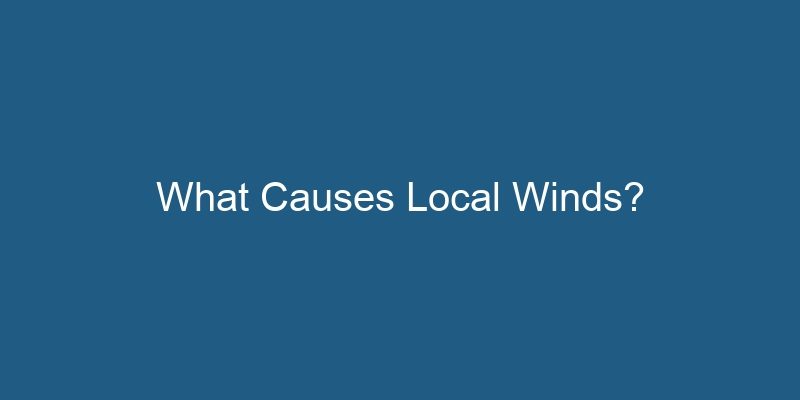Local winds are small-scale air movements that occur over a specific area and are influenced by various factors. Understanding the causes of local winds is essential for meteorologists, pilots, sailors, and anyone interested in weather patterns. In this article, we will explore the main factors that contribute to the formation of local winds and their effects on different regions.
- 1. Differential Heating
- 1.1 Sea and Land Breezes
- 1.2 Mountain and Valley Breezes
- 2. Topography
- 2.1 Anabatic and Katabatic Winds
- 2.2 Föhn Winds
- Local Winds-Sea and Land Breezes plus Mountain and Valley Breezes
- 3. Atmospheric Pressure
- 3.1 Chinook Winds
- 3.2 Monsoons
- 4. Geographic Location
- 4.1 Lake-Effect Snow
- 4.2 Coastal Winds
- Conclusion
1. Differential Heating
Differential heating is one of the primary factors behind the formation of local winds. It occurs when different parts of the Earth’s surface absorb and radiate heat at different rates. As a result, temperature variations develop, leading to the creation of local wind systems. There are two common types of local winds associated with differential heating:
1.1 Sea and Land Breezes
Sea and land breezes are a type of local wind that occurs near coastal areas. During the day, the land heats up faster than the adjacent water, causing the air above the land to rise. This creates a low-pressure area over the land. As a result, cooler air from the water flows towards the land, creating a sea breeze. At night, the situation reverses, and a land breeze forms as the land cools more rapidly than the water.
1.2 Mountain and Valley Breezes
Mountain and valley breezes are another example of local winds caused by differential heating. During the day, the sun heats the air in the valley faster than the air on the nearby mountain slopes. Consequently, warm air rises up the slopes, creating an upslope breeze. At night, the process reverses, and cold air descends into the valley, causing a downslope breeze.
2. Topography
The shape and features of the land, known as topography, can significantly influence local wind patterns. Mountains, hills, valleys, and bodies of water can all interact with the prevailing winds and create localized air movements. Here are some examples:
2.1 Anabatic and Katabatic Winds
Anabatic winds occur when the sun heats the slopes of a mountain, causing the air to rise. These upslope winds are commonly observed in hilly or mountainous regions. On the other hand, katabatic winds happen when cold, dense air descends down the mountain slopes at night. Both anabatic and katabatic winds can impact local weather conditions and are crucial to consider for activities like aviation and wind energy.
2.2 Föhn Winds
Föhn winds, also known as chinook or Santa Ana winds, are warm and dry downslope winds that occur on the leeward side of mountains. As moist air approaches a mountain range, it rises and cools, leading to the formation of clouds and precipitation. However, as the air descends on the opposite side of the mountain, it warms up and dries out, resulting in föhn winds. These winds can have a significant impact on local climates, often causing rapid temperature changes and increased fire risks.
Local Winds-Sea and Land Breezes plus Mountain and Valley Breezes
3. Atmospheric Pressure
Atmospheric pressure differences play a crucial role in the formation of local winds. Changes in pressure gradients can create localized air movements, resulting in various wind patterns. Here are two examples:
3.1 Chinook Winds
Chinook winds, also known as “snow eaters,” are warm and dry winds that occur on the eastern slopes of the Rocky Mountains in North America. These winds develop due to a significant difference in pressure between the mountains and the adjacent plains. As the high-pressure air from the mountains flows down towards the lower pressure region, it compresses and warms up, leading to the formation of chinook winds.
3.2 Monsoons
Monsoons are seasonal winds that occur in tropical and subtropical regions. They are driven by pressure differences between land and sea. During summer, the land heats up faster than the ocean, creating a low-pressure area over the land. As a result, moist air from the ocean flows onto the land, bringing heavy rainfall. In winter, the process reverses, and dry air flows from the land to the sea, resulting in a dry season.
4. Geographic Location
The geographic location of an area can also influence local wind patterns. Proximity to large bodies of water, such as oceans or lakes, can have a significant impact on the formation of local winds. Here are two examples:
4.1 Lake-Effect Snow
Lake-effect snow occurs when cold air passes over a relatively warm lake, causing the air to become unstable and produce snow showers downwind of the lake. This phenomenon is commonly observed in regions near the Great Lakes, where cold Arctic air interacts with the relatively warm lake waters.
4.2 Coastal Winds
Coastal winds, also known as onshore and offshore winds, are influenced by the proximity of an area to the coast. During the day, onshore winds blow from the sea towards the land as the land heats up faster. At night, offshore winds blow from the land to the sea as the land cools down more rapidly. Coastal winds can affect local weather conditions, maritime activities, and coastal ecosystems.
Conclusion
Local winds are complex phenomena influenced by various factors, including differential heating, topography, atmospheric pressure, and geographic location. Understanding the causes and characteristics of local winds is essential for predicting weather patterns, planning outdoor activities, and ensuring safety in different regions. By analyzing these factors, meteorologists can provide valuable insights into local wind behaviors and their impacts on our daily lives.

